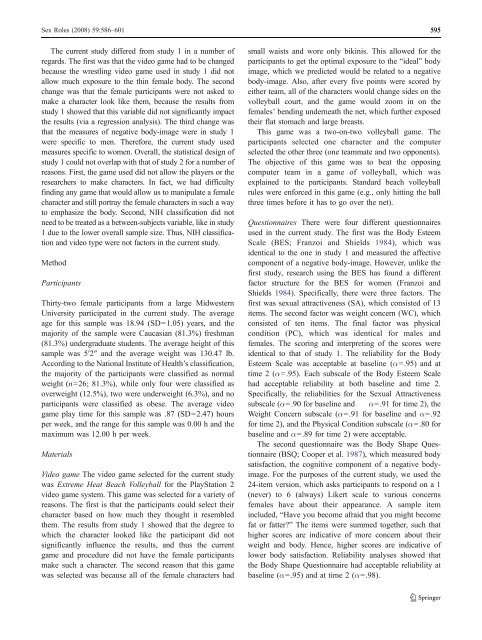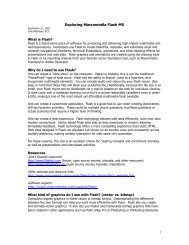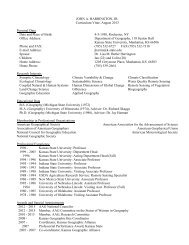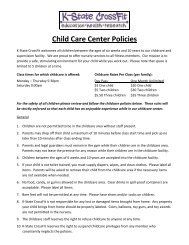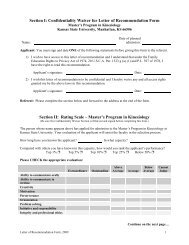The Impact of Body Emphasizing Video Games on Body Image ...
The Impact of Body Emphasizing Video Games on Body Image ...
The Impact of Body Emphasizing Video Games on Body Image ...
- No tags were found...
You also want an ePaper? Increase the reach of your titles
YUMPU automatically turns print PDFs into web optimized ePapers that Google loves.
Sex Roles (2008) 59:586–601 595<str<strong>on</strong>g>The</str<strong>on</strong>g> current study differed from study 1 in a number <str<strong>on</strong>g>of</str<strong>on</strong>g>regards. <str<strong>on</strong>g>The</str<strong>on</strong>g> first was that the video game had to be changedbecause the wrestling video game used in study 1 did notallow much exposure to the thin female body. <str<strong>on</strong>g>The</str<strong>on</strong>g> sec<strong>on</strong>dchange was that the female participants were not asked tomake a character look like them, because the results fromstudy 1 showed that this variable did not significantly impactthe results (via a regressi<strong>on</strong> analysis). <str<strong>on</strong>g>The</str<strong>on</strong>g> third change wasthat the measures <str<strong>on</strong>g>of</str<strong>on</strong>g> negative body-image were in study 1were specific to men. <str<strong>on</strong>g>The</str<strong>on</strong>g>refore, the current study usedmeasures specific to women. Overall, the statistical design <str<strong>on</strong>g>of</str<strong>on</strong>g>study 1 could not overlap with that <str<strong>on</strong>g>of</str<strong>on</strong>g> study 2 for a number <str<strong>on</strong>g>of</str<strong>on</strong>g>reas<strong>on</strong>s. First, the game used did not allow the players or theresearchers to make characters. In fact, we had difficultyfinding any game that would allow us to manipulate a femalecharacter and still portray the female characters in such a wayto emphasize the body. Sec<strong>on</strong>d, NIH classificati<strong>on</strong> did notneed to be treated as a between-subjects variable, like in study1 due to the lower overall sample size. Thus, NIH classificati<strong>on</strong>and video type were not factors in the current study.MethodParticipantsThirty-two female participants from a large MidwesternUniversity participated in the current study. <str<strong>on</strong>g>The</str<strong>on</strong>g> averageage for this sample was 18.94 (SD=1.05) years, and themajority <str<strong>on</strong>g>of</str<strong>on</strong>g> the sample were Caucasian (81.3%) freshman(81.3%) undergraduate students. <str<strong>on</strong>g>The</str<strong>on</strong>g> average height <str<strong>on</strong>g>of</str<strong>on</strong>g> thissample was 5′2″ and the average weight was 130.47 lb.According to the Nati<strong>on</strong>al Institute <str<strong>on</strong>g>of</str<strong>on</strong>g> Health’s classificati<strong>on</strong>,the majority <str<strong>on</strong>g>of</str<strong>on</strong>g> the participants were classified as normalweight (n=26; 81.3%), while <strong>on</strong>ly four were classified asoverweight (12.5%), two were underweight (6.3%), and noparticipants were classified as obese. <str<strong>on</strong>g>The</str<strong>on</strong>g> average videogame play time for this sample was .87 (SD=2.47) hoursper week, and the range for this sample was 0.00 h and themaximum was 12.00 h per week.Materials<str<strong>on</strong>g>Video</str<strong>on</strong>g> game <str<strong>on</strong>g>The</str<strong>on</strong>g> video game selected for the current studywas Extreme Heat Beach Volleyball for the PlayStati<strong>on</strong> 2video game system. This game was selected for a variety <str<strong>on</strong>g>of</str<strong>on</strong>g>reas<strong>on</strong>s. <str<strong>on</strong>g>The</str<strong>on</strong>g> first is that the participants could select theircharacter based <strong>on</strong> how much they thought it resembledthem. <str<strong>on</strong>g>The</str<strong>on</strong>g> results from study 1 showed that the degree towhich the character looked like the participant did notsignificantly influence the results, and thus the currentgame and procedure did not have the female participantsmake such a character. <str<strong>on</strong>g>The</str<strong>on</strong>g> sec<strong>on</strong>d reas<strong>on</strong> that this gamewas selected was because all <str<strong>on</strong>g>of</str<strong>on</strong>g> the female characters hadsmall waists and wore <strong>on</strong>ly bikinis. This allowed for theparticipants to get the optimal exposure to the “ideal” bodyimage, which we predicted would be related to a negativebody-image. Also, after every five points were scored byeither team, all <str<strong>on</strong>g>of</str<strong>on</strong>g> the characters would change sides <strong>on</strong> thevolleyball court, and the game would zoom in <strong>on</strong> thefemales’ bending underneath the net, which further exposedtheir flat stomach and large breasts.This game was a two-<strong>on</strong>-two volleyball game. <str<strong>on</strong>g>The</str<strong>on</strong>g>participants selected <strong>on</strong>e character and the computerselected the other three (<strong>on</strong>e teammate and two opp<strong>on</strong>ents).<str<strong>on</strong>g>The</str<strong>on</strong>g> objective <str<strong>on</strong>g>of</str<strong>on</strong>g> this game was to beat the opposingcomputer team in a game <str<strong>on</strong>g>of</str<strong>on</strong>g> volleyball, which wasexplained to the participants. Standard beach volleyballrules were enforced in this game (e.g., <strong>on</strong>ly hitting the ballthree times before it has to go over the net).Questi<strong>on</strong>naires <str<strong>on</strong>g>The</str<strong>on</strong>g>re were four different questi<strong>on</strong>nairesused in the current study. <str<strong>on</strong>g>The</str<strong>on</strong>g> first was the <str<strong>on</strong>g>Body</str<strong>on</strong>g> EsteemScale (BES; Franzoi and Shields 1984), which wasidentical to the <strong>on</strong>e in study 1 and measured the affectivecomp<strong>on</strong>ent <str<strong>on</strong>g>of</str<strong>on</strong>g> a negative body-image. However, unlike thefirst study, research using the BES has found a differentfactor structure for the BES for women (Franzoi andShields 1984). Specifically, there were three factors. <str<strong>on</strong>g>The</str<strong>on</strong>g>first was sexual attractiveness (SA), which c<strong>on</strong>sisted <str<strong>on</strong>g>of</str<strong>on</strong>g> 13items. <str<strong>on</strong>g>The</str<strong>on</strong>g> sec<strong>on</strong>d factor was weight c<strong>on</strong>cern (WC), whichc<strong>on</strong>sisted <str<strong>on</strong>g>of</str<strong>on</strong>g> ten items. <str<strong>on</strong>g>The</str<strong>on</strong>g> final factor was physicalc<strong>on</strong>diti<strong>on</strong> (PC), which was identical for males andfemales. <str<strong>on</strong>g>The</str<strong>on</strong>g> scoring and interpreting <str<strong>on</strong>g>of</str<strong>on</strong>g> the scores wereidentical to that <str<strong>on</strong>g>of</str<strong>on</strong>g> study 1. <str<strong>on</strong>g>The</str<strong>on</strong>g> reliability for the <str<strong>on</strong>g>Body</str<strong>on</strong>g>Esteem Scale was acceptable at baseline (α=.95) and attime 2 (α=.95). Each subscale <str<strong>on</strong>g>of</str<strong>on</strong>g> the <str<strong>on</strong>g>Body</str<strong>on</strong>g> Esteem Scalehad acceptable reliability at both baseline and time 2.Specifically, the reliabilities for the Sexual Attractivenesssubscale (α=.90 for baseline and α=.91 for time 2), theWeight C<strong>on</strong>cern subscale (α=.91 for baseline and α=.92for time 2), and the Physical C<strong>on</strong>diti<strong>on</strong> subscale (α=.80 forbaseline and α=.89 for time 2) were acceptable.<str<strong>on</strong>g>The</str<strong>on</strong>g> sec<strong>on</strong>d questi<strong>on</strong>naire was the <str<strong>on</strong>g>Body</str<strong>on</strong>g> Shape Questi<strong>on</strong>naire(BSQ; Cooper et al. 1987), which measured bodysatisfacti<strong>on</strong>, the cognitive comp<strong>on</strong>ent <str<strong>on</strong>g>of</str<strong>on</strong>g> a negative bodyimage.For the purposes <str<strong>on</strong>g>of</str<strong>on</strong>g> the current study, we used the24-item versi<strong>on</strong>, which asks participants to resp<strong>on</strong>d <strong>on</strong> a 1(never) to 6 (always) Likert scale to various c<strong>on</strong>cernsfemales have about their appearance. A sample itemincluded, “Have you become afraid that you might becomefat or fatter?” <str<strong>on</strong>g>The</str<strong>on</strong>g> items were summed together, such thathigher scores are indicative <str<strong>on</strong>g>of</str<strong>on</strong>g> more c<strong>on</strong>cern about theirweight and body. Hence, higher scores are indicative <str<strong>on</strong>g>of</str<strong>on</strong>g>lower body satisfacti<strong>on</strong>. Reliability analyses showed thatthe <str<strong>on</strong>g>Body</str<strong>on</strong>g> Shape Questi<strong>on</strong>naire had acceptable reliability atbaseline (α=.95) and at time 2 (α=.98).


